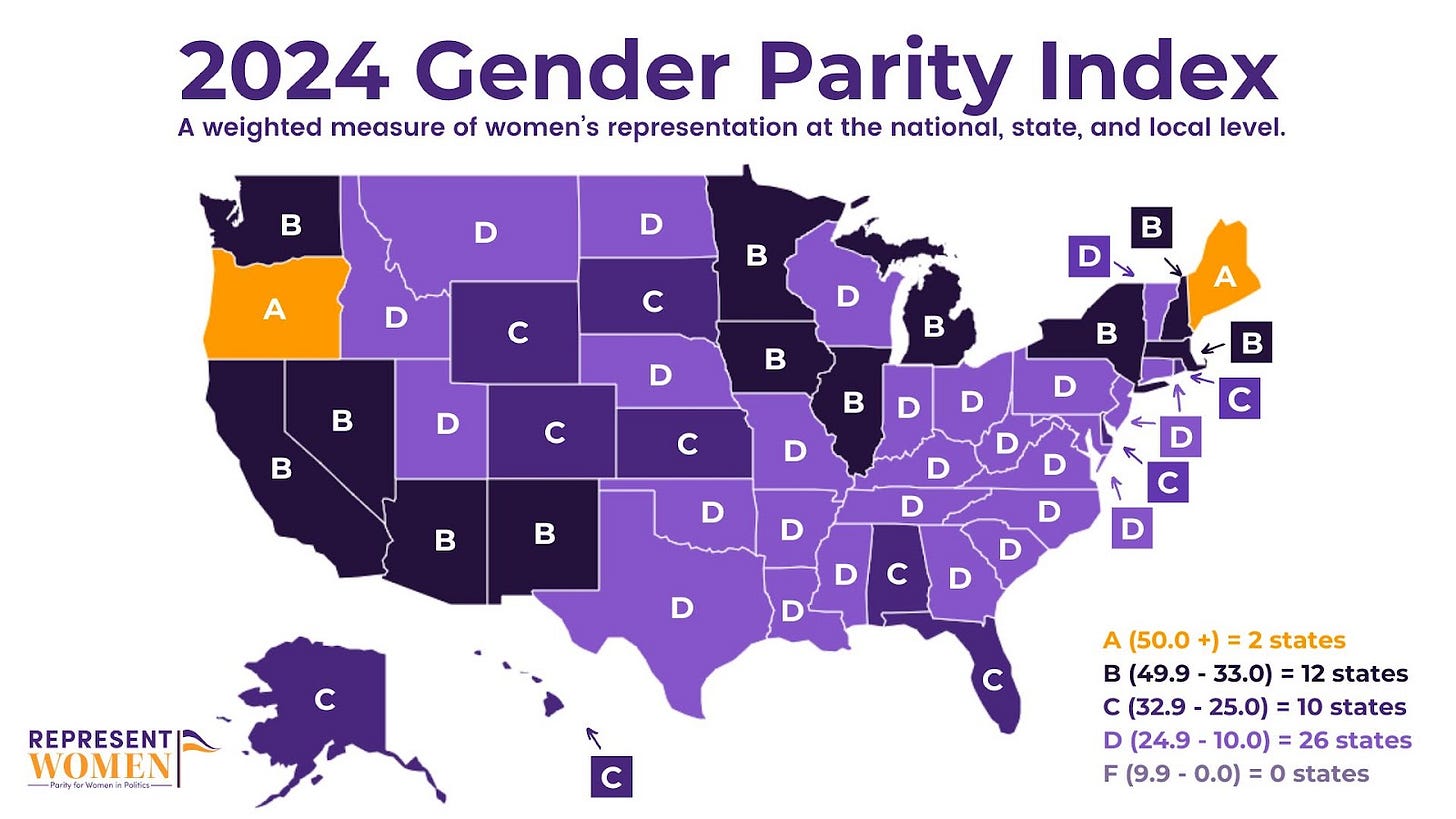Despite Kamala Harris candidacy, US women's representation is stagnating
RepresentWomen’s annual Gender Parity Index shows retrenchment amidst some progress
[Editor’s note: RepresentWomen, the leading organization in the United States advancing the reforms necessary to increase women’s representation, recently issued its annual report on “gender parity.” This report should be read every year by Americans who are concerned about the direction of our country. The US needs many changes and reforms to modernize and haul our antiquated 18th century-based political institutions into the 21st century. The measuring stick those reforms should be judged by are: will they increase women’s representation? The Gender Parity Index report is a crucial data point on my political calendar — Steven Hill]
By Courtney Lamendola and Steph Scaglia
As the nation heads toward a bruising presidential election, with attention focused on the horse race dynamics of winners and losers, it’s easy to lose sight of some underlying factors that define our political landscape.
Despite the fact that Vice President Kamala Harris is poised to win the Democratic Party’s presidential nomination, women remain vastly underrepresented. Women are more than half of the nation’s population yet they are still significantly absent from the seats of power at all levels of government. They hold just one-third of all elected positions in 2024, and only 28% of all Congressional seats.
Not only that, but despite the record gains women made in the years following the 2018 “Year of the Woman,” wins for women appear to be slowing down. Outdated rules and systems create an unlevel playing field, limiting opportunities for women to enter and remain in politics. As a result, progress in the US toward gender balance has been slower and more uneven than it should be. Systemic political reform is needed to enable more women to run, win, serve, and lead.
To illustrate how far women have come, yet how much further they still have to go, RepresentWomen recently published our 11th annual Gender Parity Index, a comprehensive measure of women’s representation at the national, state, and local levels of government. See the results below.
The Gender Parity Index, first launched in 2013, awards each of the 50 states a score (0-100), letter grade (A-F), and ranking (1-50) based on that state’s proximity to gender parity. A perfect score is 50/100. Eleven years ago, 40 states earned “D” grades (< 25.0 points) or “F” grades (< 10.0 points), and the remaining 10 states were split evenly between “C” grades (< 33.0) and “B” grades (< 50.0). No state earned an “A” grade until New Hampshire from 2015-2018, and then again in 2020.
This year, Oregon and Maine received “A” grades for the second time, but the case of New Hampshire, which has dropped from an “A” grade, shows the importance of tracking representation over time. Despite Oregon and Maine’s success, the majority of states earned “D” grades, and the remaining twenty-two states earned “B” and “C” grades. On a positive note, for the first time ever, no state received a failing grade. Louisiana, the only state to receive an “F” for eight years straight (2016-2023), made major gains, electing its first woman Attorney General, Liz Murril, and second woman Secretary of State, Nancy Landry.
Earlier this year, RepresentWomen analyzed the composition of the U.S. House of Representatives: Party Composition by Gender 2013-2024. We found that although less than 30% of all U.S. Representatives are women, almost half (43%) of Democratic representatives are women. But only 28% of Republican Representatives are women. Unless (a) more Democratic women are elected than men, or (b) more Republican women are elected – which we know is unlikely this cycle – progress to parity will likely slow.
Additional research from the Center for American Women in Progress supports this: the number of major-party women congressional candidates in 2024 has fallen by 20% in the U.S. House and by 26% in the U.S. Senate. This decline is seen in both Democrats and Republicans, emphasizing that without intentional action, progress is not self-sustaining.
Headlines that celebrate record-breaking wins for women’s representation often overshadow the reality of stagnation in the number of women running for office at national, state, and local levels. US women remain underrepresented at every level of government, with only 28% of seats in the US Congress. That’s much lower than many of their international counterparts. New Zealand has over 50% women in its parliament, Sweden and Finland have 46%, Norway and Australia 45%, Belgium and Denmark 44%, Spain and Austria 41%, France 36% and Germany 35%.
One step forward…one step back?
The 2024 Index reflects our complex political landscape, suggesting progress in women’s political representation may stagnate or even backslide. This index shows the most movement for women at the state and local levels: Louisiana elected two new woman state executives, and Indiana elected nine new women to local offices. But incremental score changes by one or two points do not necessarily reflect the broad, system-wide movements needed to elect women to all levels of government. To make lasting progress in women’s representation, we must take a systems-level approach that creates opportunities for women to enter the political sphere and supports the women already in office. This year’s Index finds:
The U.S. remains over halfway to a parity 50 out of 100 score, with an average Parity Score of 27. However, in contrast to 2023, fewer states have passed the halfway mark: only 24 of the 50 states earned above 25 points.
For the first time in the Index's history, no state earns an “F” grade. After eight consecutive years of scoring under 10 points, Louisiana earned its first “D” grade and moved up to 45th place. This shows just how consequential a single election cycle can be, especially with open seats.
To sustain progress, we need better support for elected women. The decline in incumbent women running for Congress this cycle suggests that progress will likely plateau or regress if we do not ensure a modern and safe work environment in which working women and mothers have support for their various needs.
Progress must occur across all levels of government. Vermont’s case shows that gains at one level can be counterbalanced by losses at another, ultimately decreasing the overall score.
Systemic change is needed — ranked choice voting, proportional voting and more
So what changes will help elect more women candidates? Our research specifies the barriers women face when running, winning, and serving. These include funding and support disparities from political parties and other major donors, media bias, unfair electoral systems, imbalanced caregiving responsibilities, and lack of mentorship networks. However, our research also shows that actionable solutions exist and have led to success. Changing our systems to support women within the party establishment, implementing ranked choice voting, proportional representation, and instituting fair legislative practices, are all viable methods for getting women to run, win, and serve effectively in political office.
The 2024 presidential race demonstrates such change, with Kamala Harris well-positioned to win the Democratic party nomination for president of the United States and become the first Black woman and first Asian American person to do so. Harris’ candidacy would undoubtedly advance the conversation of women’s viability to hold political leadership positions, including in the down-ballot races that will shape changes in the 2025 Gender Parity Index.
Achieving gender-balanced governance is not a one-time goal. Sustaining women’s representation requires enacting institutional changes that equalize the playing field for women in the long term. We need to view our lack of political gender balance with a sense of urgency if we are to build a system that achieves gender balance within our lifetimes.
Courtney Lamendola @Lamendola_ and Steph Scaglia @ScagliaSteph
Courtney Lamendola and Steph Scaglia are, respectively, research director and research manager for RepresentWomen, a think tank and action hub dedicated to strengthening our democracy through achieving gender balanced governance.








